
Contemporary political Europe is being built on a principle whereby physical borders will disappear. The Schengen area is gradually seeing boundaries between European Union members states being done away with, thus symbolically erasing a factor that lay at the root of the 20th century’s two world wars. In specific ways, however, and with visible violence, border areas and buffer zones—“suspended spaces”—are unsettling Europe’s geography, like so many flash points and areas of tension.
The town of Famagusta in Cyprus is one such point—a partly closed town, emptied of its inhabitants in 48 hours, occupied by the Turkish army and guarded by the UN since 1974, the year when the armed conflict between Greece and Turkey ended.
In the book Suspended Spaces, Famagusta is a metaphor of an aesthetic and political construct.
In August 1974, Famagusta was still a seaside town and resort, and one that would be bound to enjoy the development implicit in mass tourism. Apartment blocks, hotels, and modern-style residences were under construction. But for more than 35 years, with many of them still unfinished, they have been offering just their skeletal carcasses to passing eyes. In the town abandoned by human beings, fauna and flora are flourishing. These days, not far away, on the other side of the barbed wire fences, in model settings, tourists from all over the world enjoy the sun on the beach. Not far away, either, hotel complexes with similar architecture thrive. And not much further away still, illegal immigrants are washed up on these shores, seeking a way into to Europe.
The closeness of these juxtaposed realities makes up the town’s strange character and provides many a line of questioning in the book.
Famagusta is at once an aberration and a key.
Famagusta was a disconcerting springboard for a group project because, in addition to the fact that it is only physically accessible from without, even its surroundings are elusive. While the 1974 war sometimes clings to people’s memories, many are unaware of the existence of this deserted town, and have no idea whatsoever about the lack of resolution to the Cypriot problem. What is more, the conflict does not necessarily date from the 1974 attack launched by the Turkish army; there was lethal combat further back, in 1958, when the island was still under British rule. On top of which, the history of Cyprus has always been one of wars, and successive invasions. Since Antiquity, the island has been Persian, Roman, Byzantine, Christian and then Turkish. In 1878, it came under British mandate. In 1960 it became the independent Republic of Cyprus. In the wake of the Turkish army’s intervention in 1974, the island was then cut in two, with 30% of it Turkish Cypriot. In 1983, the Turkish Republic of North Cyprus was declared, but recognized solely by Turkey, and not by the international community.
Cyprus’s history is neither evident, nor cut-and-dried, nor consensual. And the aim of this book is definitely not to come up with answers, or offer theoretical solutions, but rather to raise issues and questions, formulate uncertainties, and outline approaches. A memory-related task is also undertaken through readings of the present, the inevitable counterpart to which is political questioning.
“From Famagusta” is a way of thinking about Europe based on its sidelines, its absences, its overlooked factors, and its forms of otherness.
With, and over and above, the Cypriot issue, the Suspended Spaces project is a collective experiment involving an intellectual and visual shift, in which the town of Famagusta is a paradigm.
It is probably possible to understand this approach as the simple exercise of what Emmanuel Kant called the “visiting right”, the right to be exposed to what is foreign as a foreigner. The visiting right is part and parcel of an ephemeral time-frame—it can only be exercised in passing. The earth belongs to everyone and can be visited without any restrictions precisely “by dint of the right of common possession of the earth’s surface”. This is a right recognized by one and all, everywhere. It is a not a product of history, but a natural attribute of the human condition. In this right, and its corollary, hospitality, Emmanuel Kant saw the foundation of a cosmopolitan right—and a condition of universal peace. Beyond any form of utopianism, what is involved is exercising the citizen’s status, beyond any frontiers: accepting displacement and movement in a thoroughly curious way, and with all due feeling, as a work space. The difference of a journey that is not just “leisure”, but a collective research postulate.
The Suspended Spaces-Famagusta project has been played out in several phases: a team of international researchers came up with the idea of a residency in Cyprus. There, thinkers, writers and artists came face to face with Famagusta. From that encounter “with the terrain” was born an exhibition in Amiens. Then, in a third phase, which was informed by the first two, this book was prepared.
In it, visual, plastic and textual propositions all hobnob. Artists and authors espouse original ideas (portfolios, essays, discussions), bounded by the two covers of a book. Without any attempt at consensus, Suspended Spaces-Famagusta expresses the eclectic nature of various viewpoints about a complex historical and political reality on the sidelines within Europe. Reading between the lines, what is also involved is a challenge with regard to the conditions of the various current productions, lines of thinking and artistic activities within this initial displacement, and within this difference proposed as a postulate.
The book is in four sections (situations, positions, orientations, productions), which thus outline a perceptible and intellectual mapping in which textual and visual ideas follow on one from the other, respond to each other, and at times contradict each other. It was important not to offer any uniform reading, but rather to orchestrate a dynamic within the book which best preserves the special and unusual nature of the propositions made. There is not theory on the one hand, and practice on the other, but parallel research projects, all game for discussion.
Without being a research method, strictly speaking, Suspended Spaces proposes a modus operandi which has been adapted and re-defined on the basis of the territory it focuses on. So the project has a migratory brief, in which Suspended Spaces-Famagusta is the first chapter.
Léa Gauthier
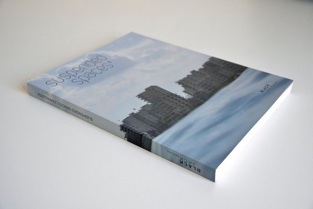
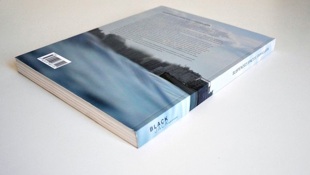
Editions BlackJack
Texts by Lionel Ruffel, Paul Ardenne, Seloua Luste Boulbina, Brian Holmes, Claire Mauss-Copeaux & Etienne Copeaux, Jacinto Lageira, Victor Burgin, Françoise Coblence, Françoise Parfait, Eric Valette, Charlène Dinhut, Christina Vatsella.
2011
21 x 27 cm (softcover)
328 pages (color ill.)
ISBN: 978-2-918063-10-0
EAN: 9782918063100
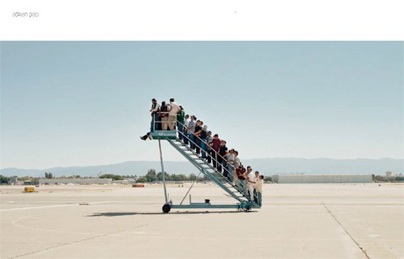
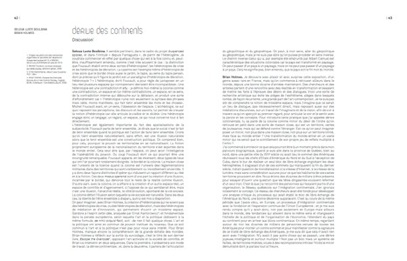
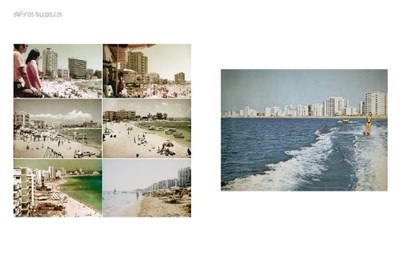
List of Contents
I. SITUATIONS - pp.12-13
Portfolios
• Berger&Berger, GhostTowns, world map of vanished cities and towns. pp. 14-17
• Pravdoliub Ivanov, Untitled, a graphic work around the shape of the map of Cyprus. pp. 18-21
• Varosha by Lionel Ruffel pp. 22-29
• Post-tourism - discussion between Paul Ardenne and Lionel Ruffel pp. 30-33
• An Isle Adrift in the Sand by Seloua Luste Boulbina pp. 34-41
• Continental Drift - discussion between Seloua Luste Boulbina and Brian Holmes pp. 42-51
Portfolios
• Marcel Dinahet, Famagusta – Varosha, photographs of Varosha from the water. pp. 52-55
• Lia Lapithi, Defining silence, extract from the photographic panoramic tour of the enclosed town of Varosha. pp. 56-61
• Christian Barani, Untitled, photographs of tourists in Cyprus. pp.62-65
• Christophe Viart, Untitled, photographs of objects referring to the expression Suspended spaces, a bench and a look-out post on a Mexican beach. pp. 66-69
• Köken Ergun, Interview of the artist by Özge Ersoy, critic and curator. pp. 70-73
• Adrian Paci, Photograph taken during the shooting of the film Centro di permaneza temporanea (2007). pp. 74-75
Videograms taken from Klodi (2005) in which Klodi, an Albanian exile, tells his story. pp. 76-77
• Jan Kopp, The House, drawings made based on a photograph taken in North Cyprus. pp.78-81
II. POSITIONS
• The investigation and the photo by Claire Mauss-Copeaux & Etienne Copeaux pp.84-97
-
•History as art by Jacinto Lageira pp.98-109
Portfolios
• Filip Berte, Untitled, a drawing made using architectural features of the beach in Famagusta and a drawing made using architectural features of the Green Line, Nicosia. pp. 110-113
• Armin Linke, Serap Kanay et Aristide Antonas, Photographic documents and writings associated with the Life project about drinking water infrastructure in Cyprus. pp. 114-117
• Ziad Antar, Untitled, photograph of the church of Saint Arsenios under construction, Limassol, Cyprus. pp118-119
Untitled, photographic contact sheet, 6x6. Beach and closed town of Varosha ; old town of Famagusta (Lala Mustapha Pacha mosque ; walls). pp 120-121
Untitled, photographs of the village of Souskiou, in the Greek Cypriot part, of abandoned Turkish Cypriot villages, of a drawing found in a restaurant near Souskiou, and of Varosha. pp. 122-123
• Antoine Boutet, Untitled, appropriation of found photos. pp.124-125
• François Bellenger, Untitled, simulations of building projects on the Green Line at Nicosia. pp.126-129
• Mira Sanders, Shortreader, photographs of a maquette made of drawings and re-created after a wander around the Green Line at Nicosia. pp.130-135
• Yiannis Toumazis, CHER CHRISTAKI…, text of the letter sent to an old Cypriot soldier, whose identity card is on display in a showcase at the Turkish Army Museum in Istanbul. Photographs. pp.136-139
• Sophie Ristelhueber, Over there, montage of family photographs taken during holidays in Crete, August 1974, during the second “Atilla” offensive by the Turkish army in Cyprus. pp.140-143
III. ORIENTATIONS
• Facing History by Victor Burgin pp. 146-155
• Anamneses by Françoise Coblence pp.156-165
• An Experiment in Off-centering by Françoise Parfait pp.166-175
Portfolios
• Elizabeth Hoak Doering, Things, Witnesses!, drawings made by the oscillating movements of suspended objects, objects made prior to 1974 and given to the artist by Cypriots.pp.176-179
• Michael Panayotis, Untitled, Four interpretations of the expression ‘Suspended spaces’ and a post card depicting daily life in Cyprus prior to 1974 by four friends, none of them artists. pp.180-181
• Nikos Charalambidis, Assemblage of projects, executed or otherwise, related to surveillance systems and spectacle arrangements. pp. 182-185
• Eric Valette, Excerpt from the drawn diary of the Suspended spaces #1 residency. pp. 186-187
• Daniel Lê, Untitled, association of a photograph before a football match in the stadium of the Nea Salamis club of Famagusta, Larnaca, Cyprus, a post card of Famagusta and a drawing. pp.188-189
• Katerina Attalides, Associations of photographs taken from personal archives and of an excerpt from Lessness by Samuel Beckett, 1969. pp.190-193
• Armin Linke, Untitled, Selection of archival images of UN armed forces in Cyprus. Aerial views of UN positions in Cyprus. pp.194-197
• Maider Fortuné, Association of a page and a snippet of a sentence taken from the corrected proofs of To the Lighthouse by Virginia Woolf (Untitled) and the transcript of a half-second of sound recorded in Varosha (Dépli). pp. 198-203
• Yannis Kyriakides, Photographs of the burnt album of The Greek Side of my Mind by Demis Roussos recorded in 1971. pp. 204-209
• Stefanos Tsivopoulos, Untitled, a composition post cards depicting Varosha prior to 1974. pp.210-213
• Françoise Parfait, Untitled, studio photograph. Re-creation of an aerial view of Varosha using imagery taken from Google Earth. pp 214-217
• Denis Pondruel, Genealogy of the Chambre qui chute/Falling Room project. pp.218- 221
• Mehmet Yashin, Translation into ten languages of the poem La maison morte/The Dead House, written in Turkish . pp.222-227
IV. PRODUCTIONS
• Paradigmatic Space and Sensitive Territory/ A Question or Two about the Representation of Famagusta by Eric Valette pp.230-243
• Experiences of Ruins and Ghosts by Charlène Dinhut pp.244-249
• Three Kinds of Suspended Space by Christina Vatsella pp.250
Ziad Antar pp. 258-259
FAMAGUSTA | drawing and animation
Christian Barani and Bertrand Gauguet pp. 260-261
BLIND SONG | three screen video projection
François Bellenger pp. 262-263
TABULA RASA FAMAGUSTA | 8 photographs printed on tarpaulins
Berger&Berger pp. 264-265
GHOST TOWNS | publication of an ephemera
Filip Berte pp. 266-267
EUTOPIA | Installation : construction of wood and plastic
Antoine Boutet pp. 268-269
LOCATION 2009 | SOUTH WATER NORTH DISPLACEMENT (NAN SHUI BEI DIAO PROJECT) | video HD
Victor Burgin pp. 270-271
HISTORIES | sound installation
Nikos Charalambidis pp. 272-273
HOLLOW AIRPORT MUSEION | inkjet digital prints on tarpaulins
Marcel Dinahet pp. 274-275
FAMAGUSTA-VAROSHA (1), (2) and (3) | videos
Koken Ergun pp. 276-277
BINIBINING | video and PROMISED LAND | booklet
Koken Ergun et Michael Zupraner pp. 278-279
B’TSELEM ARCHIVE PROJECT | video installation
Maider Fortuné pp. 280-281
CURTAIN ! | video
Elizabeth Hoak Doering pp. 282-283
THINGS, WITNESSES | installation - objects, paper, mechanism
Pravdoliub Ivanov pp. 284-285
STAIRS OF INNOCENT | installation and LOADED | installation
Yannis Kyriakides pp. 286-287
DISCO DEBRIS | interactive sound installation
Jan Kopp pp. 288-289
THE HOUSE | animation video, colour/black and white
Lia Lapithi pp. 290-291
TURN A BLIND EYE | video | TURN A BLIND EYE | post card
Daniel Lê - Eric Valette pp. 292-295
DERBY | video and BORN TO BE RED | video
Armin Linke pp. 296-297
UNTITLED | 6 books
Armin Linke / Serap Kanay / Aristide Antonas pp. 298-299
LIFE | video
Adrian Paci pp. 300-301
CENTRO DI PERMANEZA TEMPORANEA | video
Michael Panayotis pp. 302-303
OPEN | in situ light installation
Françoise Parfait pp. 304-305
BOTANICA ENTROPICA | overhead video projection
Denis Pondruel pp. 306-307
FALLING ROOM | Installation
Sophie Ristelhueber pp. 308-309
OVER THERE | video
Mira Sanders pp. 310-311
THE JOURNEY | Installation
Yannis Toumazis pp. 312-313
CHER CHRISTAKI…II and SHOWCASE IN A BOX I-V | installation
Stefanos Tsivopoulos pp. 314-315
TERMINALS | film 16 mm
Nasan Tur pp. 316-317
A PLACE | video and SHINE | light installation
Christophe Viart pp. 318-319
NO DIVING OR JUMPING | construction – mixed technique
Mehmet Yasin pp. 320-321
DEAD HOUSE | Installation
Biographies 322-325
Suspended spaces # 1- Famagusta






